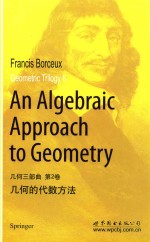

几何三部曲 第2卷 几何的代数方法 英文版PDF电子书下载
- 电子书积分:14 积分如何计算积分?
- 作 者:(比)F.博斯克斯著
- 出 版 社:世界图书出版公司
- 出版年份:2016
- ISBN:7519220753
- 页数:430 页
1 The Birth of Analytic Geometry 1
1.1 Fermat's Analytic Geometry 2
1.2 Descartes'Analytic Geometry 5
1.3 Moreon Cartesian Systems of Coordinates 6
1.4 Non-Cartesian Systems of Coordinates 9
1.5 Computing Distances and Angles 11
1.6 Planes and Lines in Solid Geometry 15
1.7 The Cross Product 17
1.8 Forgetting the Origin 19
1.9 The Tangent to a Curve 24
1.10 The Conics 27
1.11 The Ellipse 29
1.12 The Hyperbola 31
1.13 The Parabola 34
1.14 The Quadrics 37
1.15 The Ruled Quadrics 43
1.16 Problems 47
1.17 Exercises 49
2 Affine Geometry 51
2.1 Affine Spaces over a Field 52
2.2 Examples of Affine Spaces 55
2.3 Affine Subspaces 56
2.4 Parallel Subspaces 58
2.5 Generated Subspaces 59
2.6 Supplementary Subspaces 60
2.7 Lines and Planes 61
2.8 Barycenters 63
2.9 Barycentric Coordinates 65
2.10 Triangles 66
2.11 Parallelograms 70
2.12 Affine Transformations 73
2.13 Affine Isomorphisms 75
2.14 Transiations 78
2.15 Projections 79
2.16 Symmetries 80
2.17 Homotheties and Affinities 83
2.18 The Intercept Thales Theorem 84
2.19 Affine Coordinates 86
2.20 Change of Coordinates 87
2.21 The Equations of a Subspace 88
2.22 The Matrix of an Affine Transformation 89
2.23 The Quadrics 91
2.24 The Reduced Equation of a Quadric 93
2.25 The Symmetries of a Quadric 96
2.26 The Equation of a Non-degenerate Quadric 100
2.27 Problems 108
2.28 Exercises 110
3 More on Real Affine Spaces 119
3.1 About Left,Right and Between 119
3.2 Orientation of a Real Affine Space 121
3.3 Direct and Inverse Affine Isomorphisms 125
3.4 Parallelepipeds and Half Spaces 125
3.5 Pasch's Theorem 128
3.6 Affine Classification of Real Quadrics 129
3.7 Problems 134
3.8 Exercises 135
4 Euclidean Geometry 137
4.1 Metric Geometry 137
4.2 Defining Lengths and Angles 138
4.3 Metric Properties of Euclidean Spaces 140
4.4 Rectangles,Diamonds and Squares 144
4.5 Examples of Euclidean Spaces 146
4.6 Orthonormal Bases 149
4.7 Polar Coordinates 152
4.8 Orthogonal Projections 154
4.9 Some Approximation Problems 156
4.10 Isometries 161
4.11 Classification of Isometries 163
4.12 Rotations 165
4.13 Similarities 170
4.14 Euclidean Quadrics 173
4.15 Problems 174
4.16 Exercises 176
5 Hermitian Spaces 181
5.1 Hermitian Products 181
5.2 Orthonormal Bases 184
5.3 The Metric Structure of Hermitian Spaces 187
5.4 Complex Quadrics 189
5.5 Problems 192
5.6 Exercises 193
6 Projective Geometry 195
6.1 Projective Spaces over a Field 195
6.2 Projective Subspaces 198
6.3 The Duality Principle 200
6.4 Homogeneous Coordinates 202
6.5 Projective Basis 205
6.6 The Anharmonic Ratio 207
6.7 Projective Transformations 209
6.8 Desargues'Theorem 215
6.9 Pappus'Theorem 219
6.10 Fano's Theorem 223
6.11 Harmonic Quadruples 225
6.12 The Axioms of Projective Geometry 226
6.13 Projective Quadrics 227
6.14 Duality with Respect to a Quadric 231
6.15 Poles and Polar Hyperplanes 232
6.16 Tangent Space to a Quadric 235
6.17 Projective Conics 236
6.18 The Anharmonic Ratio Along a Conic 242
6.19 The Pascal and Brianchon Theorems 246
6.20 Affine Versus Projective 250
6.21 Real Quadrics 256
6.22 The Topology of Projective Real Spaces 261
6.23 Problems 263
6.24 Exercises 264
7 Algebraic Curves 267
7.1 Looking for the Right Context 268
7.2 The Equation of an Algebraic Curve 270
7.3 The Degree of a Curve 273
7.4 Tangents and Multiple Points 276
7.5 Examples of Singularities 283
7.6 Inflexion Points 287
7.7 The Bezout Theorem 292
7.8 Curves Through Points 303
7.9 The Number of Multiplicities 307
7.10 Conics 310
7.11 Cubics and the Cramer Paradox 311
7.12 Inflexion Points of a Cubic 316
7.13 The Group of a Cubic 322
7.14 Rational Curves 326
7.15 A Criterion of Rationality 331
7.16 Problems 337
7.17 Exercises 339
Appendix A Polynomials over a Field 341
A.1 Polynomials Versus Polynomial Functions 341
A.2 Euclidean Division 342
A.3 The Bezout Theorem 344
A.4 Irreducible Polynomials 346
A.5 The Greatest Common Divisor 347
A.6 Roots of a Polynomial 349
A.7 Adding Roots to a Polynomial 351
A.8 The Derivative of a Polynomial 354
Appendix B Polynomials in Several Variables 359
B.1 Roots 359
B.2 Polynomial Domains 362
B.3 Quotient Field 364
B.4 Irreducible Polynomials 366
B.5 Partial Derivatives 370
Appendix C Homogeneous Polynomials 373
C.1 Basic Properties 373
C.2 Homogeneous Versus Non-homogeneous 376
Appendix D Resultants 379
D.1 The Resultant of two Polynomials 379
D.2 Roots Versus Divisibility 384
D.3 The Resultant of Homogeneous Polynomials 387
Appendix E Symmetric Polynomials 391
E.1 Elementary Symmetric Polynomials 391
E.2 The Structural Theorem 392
Appendix F Complex Numbers 397
F.1 The Field of Complex Numbers 397
F.2 Modulus Argument and Exponential 398
F.3 The Fundamental Theorem of Algebra 401
F.4 More on Complex and Real Polynomials 404
Appendix G Quadratic Forms 407
G.1 Quadratic Forms over a Field 407
G.2 Conjugation and Isotropy 409
G.3 Real Quadratic Forms 411
G.4 Quadratic Forms on Euclidean Spaces 414
G.5 On Complex Quadratic Forms 415
Appendix H Dual Spaces 417
H.1 The Dual of a Vector Space 417
H.2 Mixed Orthogonality 420
References and Further Reading 423
Index 425
- 《卓有成效的管理者 中英文双语版》(美)彼得·德鲁克许是祥译;那国毅审校 2019
- 《线性代数简明教程》刘国庆,赵剑,石玮编著 2019
- 《AutoCAD 2018自学视频教程 标准版 中文版》CAD/CAM/CAE技术联盟 2019
- 《抗战三部曲 国防诗歌集》蒲风著 1937
- 《汉冶萍三部曲之烽火残阳》胡燕怀 2019
- 《跟孩子一起看图学英文》张紫颖著 2019
- 《AutoCAD机械设计实例精解 2019中文版》北京兆迪科技有限公司编著 2019
- 《高等代数 下》曹重光,生玉秋,远继霞 2019
- 《线性代数及应用》蒋诗泉,叶飞,钟志水 2019
- 《复分析 英文版》(中国)李娜,马立新 2019
- 《中风偏瘫 脑萎缩 痴呆 最新治疗原则与方法》孙作东著 2004
- 《水面舰艇编队作战运筹分析》谭安胜著 2009
- 《王蒙文集 新版 35 评点《红楼梦》 上》王蒙著 2020
- 《TED说话的力量 世界优秀演讲者的口才秘诀》(坦桑)阿卡什·P.卡里亚著 2019
- 《燕堂夜话》蒋忠和著 2019
- 《经久》静水边著 2019
- 《魔法销售台词》(美)埃尔默·惠勒著 2019
- 《微表情密码》(波)卡西亚·韦佐夫斯基,(波)帕特里克·韦佐夫斯基著 2019
- 《看书琐记与作文秘诀》鲁迅著 2019
- 《酒国》莫言著 2019
- 《TED说话的力量 世界优秀演讲者的口才秘诀》(坦桑)阿卡什·P.卡里亚著 2019
- 《小手画出大世界 恐龙世界》登亚编绘 2008
- 《近代世界史文献丛编 19》王强主编 2017
- 《课堂上听不到的历史传奇 世界政治军事名人 初中版》顾跃忠等编著 2015
- 《365奇趣英语乐园 世界民间故事》爱思得图书国际企业 2018
- 《近代世界史文献丛编 36》王强主编 2017
- 《近代世界史文献丛编 11》王强主编 2017
- 《近代世界史文献丛编 18》王强主编 2017
- 《乐队伴奏长笛世界名曲集 4》芭芭拉·哈斯勒-哈瑟 2017
- 《世界名著阅读经典 欧也妮·葛朗台 高老头 全译本 12-16岁》(法)巴尔扎克著 2017
